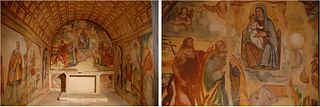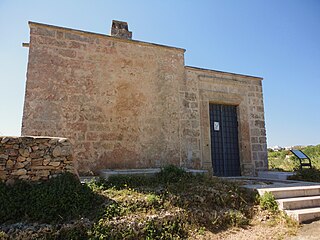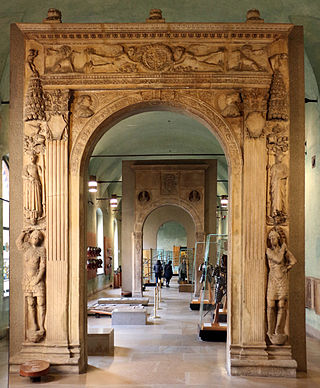
Giovanni Battista Tiepolo, also known as GiambattistaTiepolo, was an Italian painter and printmaker from the Republic of Venice who painted in the Rococo style, considered an important member of the 18th-century Venetian school. He was prolific, and worked not only in Italy, but also in Germany and Spain.

The Castello Sforzesco is a medieval fortification located in Milan, Northern Italy. It was built in the 15th century by Francesco Sforza, Duke of Milan, on the remnants of a 14th-century fortification. Later renovated and enlarged, in the 16th and 17th centuries it was one of the largest citadels in Europe. Extensively rebuilt by Luca Beltrami in 1891–1905, it now houses several of the city's museums and art collections.

Cassano d'Adda is a town and comune in the Metropolitan City of Milan, Lombardy, Italy, located on the right side of the Adda River. It is on the border of the Metropolitan City of Milan and the province of Bergamo. It is served by Cassano d'Adda railway station.

The Palazzina di caccia of Stupinigi is one of the Residences of the Royal House of Savoy in the Metropolitan City of Turin in northern Italy, part of the UNESCO World Heritage Sites list. Built as a royal hunting lodge in the early 18th century, it is located in Stupinigi, a suburb of the town of Nichelino, 10 km (6 mi) southwest of Turin.

Castelbuono is a town and comune in the Metropolitan City of Palermo, Sicily.

The Palazzo Ducale di Mantova is a group of buildings in Mantua, Lombardy, northern Italy, built between the 14th and the 17th century mainly by the noble family of Gonzaga as their royal residence in the capital of their Duchy. The buildings are connected by corridors and galleries and are enriched by inner courts and wide gardens. The complex includes some 500 rooms and occupies an area of c. 34,000 m2, which make it the sixth largest palace in Europe after the palaces of the Vatican, the Louvre Palace, the Palace of Versailles, the Royal Palace of Caserta and the Castle of Fontainebleau. It has more than 500 rooms and contains seven gardens and eight courtyards. Although most famous for Mantegna's frescos in the Camera degli Sposi, they have many other very significant architectural and painted elements.

The Castello Estense or castello di San Michele is a moated medieval castle in the center of Ferrara, northern Italy. It consists of a large block with four corner towers.

The Palazzo Grimani of Santa Maria Formosa is a State museum, located in Venice in the Castello district, near Campo Santa Maria Formosa.

Santa Maria di Castello is a church and religious complex in Genoa, Italy. Administrated for a long time by the Dominicans, it is located in the Castello hill of the city, where in the Middle Ages a bishop's fortified castle existed. The church is flanked by the large Tower of the Embriaci.

The Palazzo Biscari is a monumental private palace located on Via Museo Biscari in Catania, Sicily, southern Italy. The highly decorative interiors are open for guided tours, and used for social and cultural events.

Castello Orsini-Odescalchi is a castle in Bracciano, Lazio, Italy. It is located on the southern shore of Lake Bracciano. It was built in the 15th century, and combines the functions of a military defence structure and a civilian residence of the feudal lords of the period, the Orsini and Borgia, both papal families. As one of the largest and best-maintained castles in Italy, it also houses a museum; as a centre of cultural events, the Castello has hosted several high-profile weddings such as those of Tom Cruise/Katie Holmes, Eros Ramazzotti/Michelle Hunziker, and Petra Ecclestone/James Stunt.
Castello di Monterone, known also as Castello Piceller, is a small restored 13th-century castle in Perugia, Italy. It is located in the road that connects Perugia to Assisi, through Ponte San Giovanni. Very close to the Monastery of San Pietro and to the Church of San Bevignate, this street is one of the "royal roads", that led out of the town through the main gates of Perugia, along a road network already used by the Etruscans and Romans.

Castello di Reschio forms part of a chain of walled settlements in proximity of the Tuscan boundaries. It belonged to the county of Porta Sant’Angelo of the commune of Perugia, perched on a hillock above the valley of Pierle, along the right riverbank of the Niccone stream. Today it is part of the communal territory of Lisciano Niccone, province of Perugia.

The Castle of the Pico is a castle in the city center of Mirandola, in the province of Modena, Italy.

The Visconti Castle or Castello Visconteo of Cassano is a castle of medieval origin in Cassano d'Adda, Lombardy, Northern Italy. Its current form dates back to the 14th century, when Bernabò Visconti, lord of Milan, enlarged the existing fortification as part of a defensive system of the Visconti dominions on the Adda river. At the end of the 20th century, after a period of abandonment, it was restored and transformed into a hotel.

The Visconti Castle of Pavia is a medieval castle in Pavia, Lombardy, Northern Italy. It was built after 1360 in a few years by Galeazzo II Visconti, Lord of Milan, and used as a sovereign residence by him and his son Gian Galeazzo, first duke of Milan. Its wide dimensions induced Petrarch, who visited Pavia in the fall of 1365, to call it "an enormous palace in the citadel, a truly remarkable and costly structure". Adjacent to the castle, the Visconti created a vast walled park that reached the Certosa di Pavia, a Carthusian monastery founded in 1396 by the Visconti as well and located about 7 kilometres (4.3 mi) to the north.

The Church of Santa Maria di Costantinopoli is a church located in the municipality of Ugento, in the province of Lecce, Italy.

The New Archaeological Museum is an Italian civic museum set up in the former convent of Santa Maria della Pietà of the Observant Friars Minor, in Ugento in the province of Lecce.

The crypt of the Crucifix is an underground place of worship located in the municipality of Ugento, in the province of Lecce.

The Palazzo del Banco Mediceo or simply Banco Mediceo, was a palace in Milan, the Milanese seat of the Medici's financial exchange activities, known throughout Europe as the Medici Bank. It was one of the earliest examples of Lombard Renaissance architecture.




















